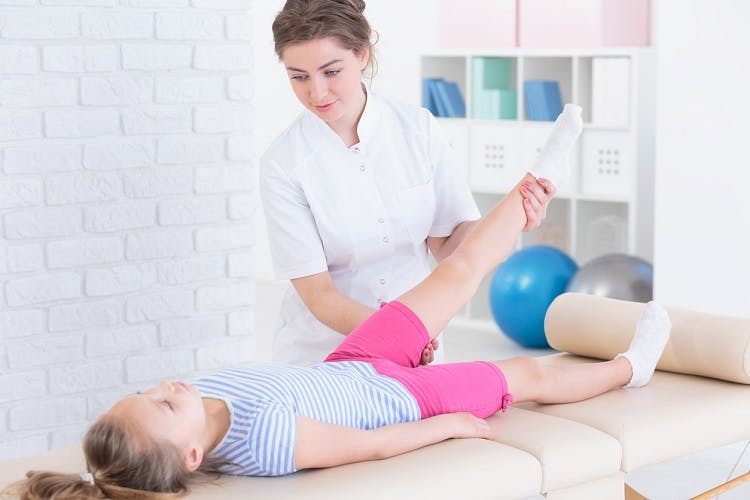Massage therapy involves the manual manipulation of soft tissues to promote both physiological and psychological relaxation. Because of its therapeutic effects on muscle tone, circulation, and stress, massage therapy may serve as an effective form of treatment for cerebral palsy.
To help you understand how massage therapy can help individuals with cerebral palsy, this article will discuss:
- 6 major benefits of massage therapy for cerebral palsy
- Is massage therapy an effective form of treatment for cerebral palsy?
Benefits of Massage Therapy for Cerebral Palsy
Many individuals with cerebral palsy try massage therapy to relax the muscles and relieve stress. During massage therapy, therapists may use their hands or arms to manually rub and knead the soft tissues, or may use specialized instruments designed to relieve muscle tension. Many massage therapists also use mineral oil or lotion during their treatments, some of which may include essential oils to further promote relaxation aromatically.
It’s important to understand that every case of cerebral palsy is unique. What provides relief for one person won’t necessarily work for another. Especially if individuals have more severe forms of cerebral palsy, more intensive interventions may be necessary.
Generally, massage therapy is not used alone, but as part of a complex therapeutic regimen consisting of physical therapy, daily stretching, medications, and orthotics to promote better functional mobility and quality of life. As a result, it can be difficult to measure the efficacy of massage therapy on its own.
To help you get a better idea of how massage therapy can help individuals with cerebral palsy, let’s discuss 6 of its major benefits.
1. Reduces Muscle Tightness

One of the most common effects of cerebral palsy is high muscle tone (spasticity). If not properly managed, the muscles can progressively contract until the point at which they are stuck in one position, significantly limiting movement.
Massage therapy helps relax spastic muscles by manually lengthening the shortened muscle fibers. By reducing muscle tone, massage therapy helps improve range of motion, motor control, and flexibility.
This study found that after 12 weeks of bi-weekly massage therapy sessions, young children with CP showed reduced spasticity and less overall muscle tone.
2. Improves Circulation
Good circulation ensures that all areas of the body have a sufficient supply of blood. Blood provides oxygen and other essential nutrients to the cells, which is vital for optimal functioning of the body.
Motor impairments caused by cerebral palsy can make it challenging for individuals to move. As a result of physical inactivity, individuals may experience poor circulation.
Massage therapy uses touch to stimulate the muscles and promote circulation, which may help compensate for reduced movement. Some massage therapists may also use heating pads as a way to further promote muscle relaxation and improve circulation.
3. Relieves Pain
High muscle tone can place excessive strain on the muscles, bones, and joints. As a result, many individuals with cerebral palsy experience chronic musculoskeletal pain.
Massage therapy promotes the release of chemicals in the brain called endorphins. They help reduce the perception of pain and produce feelings of euphoria.
Another theory called the gate control theory of pain reduction suggests that the sensory stimulation provided by massage therapy interferes with the transmission of pain stimuli to the brain. As a result, individuals may experience less pain.
4. Increases Body Awareness
A common consequence of physical inactivity is the development of pressure ulcers. Pressure ulcers describe the breakdown of skin caused by prolonged pressure.
When too much pressure is placed on one area of the body for too long, circulation gets cut off. Without a sufficient supply of blood, the tissues gradually start to die.
If not properly managed, pressure ulcers can progress into painful, open wounds that can easily become infected. Therefore, it’s essential to identify pressures ulcers in their early stages.
Massage therapy involves frequent body examination, which can help identify skin irritations early and prevent the development of pressure sores.
5. Low Risk

Massage therapy is a non-invasive and relatively affordable form of treatment for cerebral palsy.
Compared to more conventional forms of treatment such as pharmaceuticals and surgery, massage therapy has a very minimal risk of adverse side effects. Common risks associated with massage therapy include bruising or temporary soreness.
6. Reduces Stress
Another major benefit of massage therapy is its ability to promote relaxation. This can be especially helpful for individuals with cerebral palsy because they are more likely to experience anxiety and emotional distress than the general population.
Massage therapy stimulates the parasympathetic nervous system, which is responsible for regulating the body’s relaxation response. As a result, massage decreases blood pressure, heart rate, and cortisol (stress hormone) levels to calm the body down.
Is Massage Therapy an Effective Form of Treatment for Cerebral Palsy?
Like most forms of complementary and alternative medicine, few randomized controlled studies support the effectiveness of massage therapy for cerebral palsy. Due to a lack of standardization and small sample sizes, high-quality research on massage therapy is limited.
However, many people believe massage therapy does have a place in the management of cerebral palsy. For example, this study surveyed 100 families that had a child with cerebral palsy between the ages of 17 months to 21 years old. Of the surveyed parents, 86% believed that massage therapy helped relax their child’s spastic muscles, 71% reported improved quality of life, 23% reported improved quality of sleep, and 30% reported reduced pain.
Although there isn’t very much scientific evidence supporting the efficacy of massage therapy as a treatment for cerebral palsy, it is a low-risk intervention that many people with CP use regularly for psychological and physical relief.
Massage Therapy for Cerebral Palsy: Key Points
Individuals with cerebral palsy often experience tight muscles, chronic pain, and stress due to their motor impairments. Regularly receiving massage therapy a couple of times a week may help improve one’s quality of life by relaxing the muscles, promoting better blood flow, and reducing anxiety.
Ultimately, more research is necessary to verify the benefits and efficacy of massage therapy in the management of cerebral palsy. We hope this article helped inform you of the benefits of massage therapy and why it may be worth trying.











